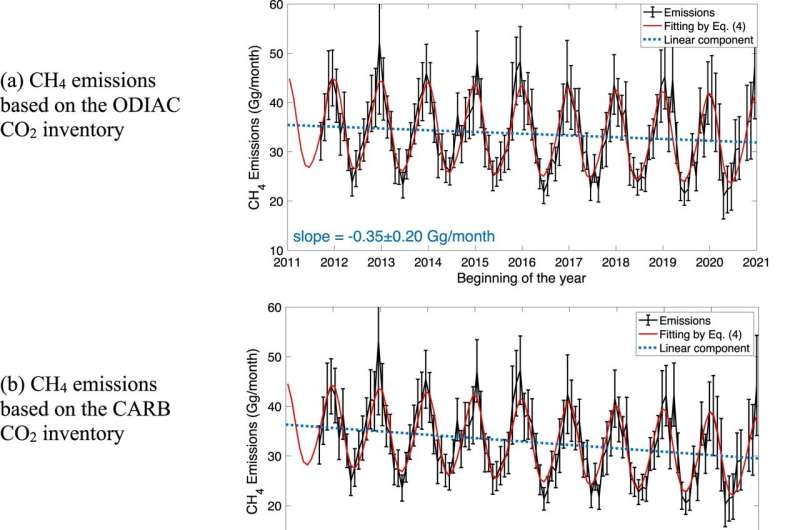This article has been reviewed according to Science X's editorial process and policies. Editors have highlighted the following attributes while ensuring the content's credibility:
fact-checked
peer-reviewed publication
trusted source
proofread
Methane emissions in LA are decreasing more slowly than previously estimated

Methane is a powerful greenhouse gas, 80 times more potent at warming the atmosphere than carbon dioxide. In 2014, a California law required statewide methane emissions to be cut by 40% by 2030 from 2013 levels. Currently, the local natural gas utility estimates that methane emissions in the Los Angeles area are decreasing at a rate of about 5.8% per year.
However, a new Caltech study shows that methane emissions in the region are decreasing at a much slower pace: 1.6% per year over the past decade. The findings indicate that more significant methane reduction efforts are needed to meet target levels. The paper is titled "Decadal decrease in Los Angeles methane emissions is much smaller than bottom-up estimates," and it was published in the journal Nature Communications on September 2.
"The state of California's goal to reduce methane emissions by 40% by 2030 below 2013 levels requires an average decrease of about 3% per year," says Yuk Yung, professor of planetary science, Jet Propulsion Laboratory (JPL) senior research scientist, and co-author on the new study. "Our commitments to decreasing greenhouse gases locally and internationally only work if we can accurately measure our progress."
The California Air Resources Board and the California Public Utility Commission are responsible for developing and implementing requirements for methane emissions reduction to meet regulatory targets. In Los Angeles, the primary source of methane emissions comes from small leaks in the natural gas pipelines that run throughout the area. The natural gas utility measures some of these leaks and estimates of how much methane is being released. However, the pipeline system is extensive, and this method of inferring emissions may be missing significant sources.
In the new study, researchers from Caltech and JPL, which Caltech manages for NASA, used an instrument called the California Laboratory for Atmospheric Remote Sensing—Fourier Transform Spectrometer (CLARS-FTS). CLARS-FTS overlooks the LA basin from atop Mount Wilson Observatory and scans the atmosphere to identify signatures of the molecules in the air. Over the past decade, it has collected information on fluctuating methane levels every day.
According to the team, this "top-down" approach of measuring methane levels in the atmosphere is much more precise than the "bottom-up" approach of estimating atmospheric levels based on ground-based measurements. With the technique, the researchers found that methane emission reductions had been overestimated: The scans showed that the actual rate of methane emission reduction was five times lower than the gas utility had estimated.
Though the state of California is implementing mitigation methods such as reducing leakage from intrastate transmission and distribution pipelines, the top-down measurement approach shows that more rigorous efforts are needed to meet emissions reductions targets.
"This study shows the need for the government to expand a monitoring network throughout more urban regions to precisely measure greenhouse gas emissions," says Yung. "It's not enough for an industry to regulate itself."
"As the country's leader in setting environmental standards, the state needs to expand its current work in the measurement, reporting, and verification of natural gas emissions from all sectors of the economy," says study co-author Stanley Sander (MS '75 Ph.D. '80), senior research scientist at JPL and a visiting associate at Caltech.
More information: Zhao-Cheng Zeng et al, Decadal decrease in Los Angeles methane emissions is much smaller than bottom-up estimates, Nature Communications (2023). DOI: 10.1038/s41467-023-40964-w
Journal information: Nature Communications
Provided by California Institute of Technology




















